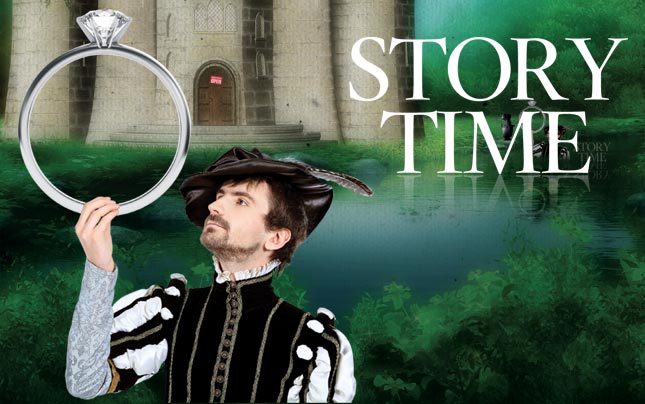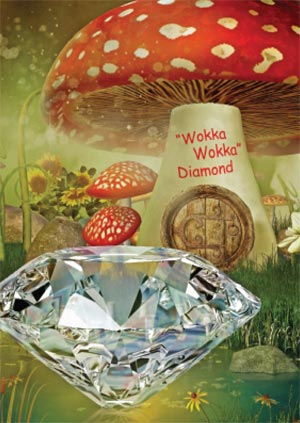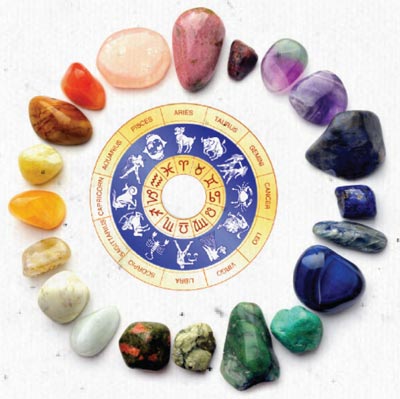
Story Time
Jewelers could recite a few product specs and make a sale. Now customers want to hear why your jewelry is special. Find the story at the heart of the sale, and you’ll live happily ever after ….
BY JOSH WIMMER
Published in the March-April 2012 issue
LET ME TELL YOU ABOUT MY WIFE’S WEDDING RING …
THE CENTER STONE is a Dream cut from Hearts On Fire. It suits her like — well, like a dream. She’s married to a jeweler’s son, so she expected a diamond of the finest quality. She doesn’t run with the pack, so she didn’t want a round; she wanted a princess cut. But she sparkles, and she wanted her stone to sparkle, too. When my dad showed her she could have a square stone that shone like a round, you could almost see her heart leap.
She wanted two wedding bands — one to wrap around each side of the engagement ring. The shanks are white, but the shoulders and top are rose gold because she loves pink. The morning after we were married at her family lake cabin, Tim Weisheipl of Anthony Jewelers in nearby Hayward, WI, opened his store — even though it was a Sunday, when they’re closed — specially, just to solder the whole works together for her.
I’m telling you about my wife’s ring for two reasons. First, she’s not here in person. If she were, she’d tell you that whole story herself. She tells it all the time. She loves her ring.
Second, I want to illustrate something you probably know but perhaps don’t think about enough: When you sell jewelry, you’re selling a story.
Advertisement
Jewelry isn’t widgets. People choose the pieces they wear for a reason. Their jewelry says something about them. It tells a story. Each piece in your case has a story. You just have to tell it. It takes some thought and practice, but it is among the most powerful ways to make a sale.
“You sell based on price, good luck to you, because there are 4,000 other SI1 Gs in your marketplace, and the only way you’re going to make that sale is to sell it cheaper. Without a story, you’re toast. You can’t survive.”
That’s Mark Moeller of R.F. Moeller in St. Paul, MN, offering his version of one story — a tragedy — you’ve surely heard by now: Diamond customers have more options than ever.
“As soon as you say, ‘Let’s talk about the four Cs,’ you sound like everybody else,” says Adam Fried, global trainer at Hearts On Fire. “And the next thing we’re gonna do is talk about price, because there’s nothing else to talk about.”
And this is only going to become more true, for diamonds and everything else you sell. Kevin Reilly of Platinum Guild International points to extensive research his group commissioned on the Millennial generation, now in their 20s. “They have four specific dominant traits: They’re mindful, expressive, entitled and competitive.,” he says. “They are really looking to get something that is unique, and one of the best ways to do that is by telling a compelling story.”
“You see this happening in a whole range of businesses,” says best-selling author and retail management consultant Daniel Pink. “Walk through the aisles of Whole Foods, and you literally see posters of stories: Here is the farmer who raised the cows that produced the milk for this yogurt. Here is the woman using this great recipe for tortillas that was passed down in her family. If you can do it with tortillas and yogurt, you should be able to do it with higher-cost, higher-margin products.”
Advertisement
Some brands have been doing it for years. Women’s clothing retailer Anthropologie beguiles shoppers with poetic product names like the Sweet Enticement Dress and Incantation Cardigan, and it fills its catalog pages with pictorial vignettes adorned with enticingly evocative phrases. Until recently, its website went even further, painting full-on pictures with the product copy — long the territory of the J. Peterman Company, which has mastered the art of crafting heartstirring prose for each item it sells. To wit: “When a man puts on this authentic French farmer’s shirt he may very well find that his hands look bigger. He will become sturdier and more forthright; either that, or more canny, only time will tell.”
This sort of thing might sound gimmicky or goofy, and it can be. Anthropologie has inspired spoof blogs like Anthroparodie, and Seinfeld affectionately lampooned J. Peterman for years. But what’s impossible to miss is that these brands are known for the stories they tell. Here’s a guide to getting yours there.
DO YOUR RESEARCH

“Specifications do not constitute the story,” warns Larry Johnson, senior vice president of Pacific Northern jewelry display company and author of The Complete Guide To Effective Jewelry Display. But, notes Adam Fried: “The more you know about a product, the more you can put into the story.”
What’s it made of, and where did it come from? Who made it, and why? How long has it been around? What are the properties of the materials used? “The manufacturer should be sharing the origins,” Johnson says, though he notes that not all of them are good at this. Online research is a useful supplement to marketing materials.
Your research shouldn’t be entirely externally directed. “The story you have to tell first is who you are as a salesperson and who your store is,” says Fried. “What’s your unique selling proposition?”
Advertisement
Look around you. What differentiates you from competitors? What niche in your community isn’t filled? Is there a “diamond guy,” a store known for its expertise and vast inventory of cuts, colors, and clarities? Are you the place to go for custom design? Or maybe you’re the new kid on the block, offering customers the chance to say they went somewhere their friends haven’t been.
A great way to figure this out is to ask questions — just as you have to read a lot to be a good writer, you must listen to be a good storyteller. A white paper by business strategy agency Anecdote recommends you ask specific questions (“What’s the most delightful experience you’ve had at our store?”), collect the anecdotes that result, and look for patterns. This is a good way to get into the right mind-set, too, says Dan Pink: “Harvest stories from customers as a way to remind your sales force why they’re in the business in the first place. Actually getting those stories in writing — or even bringing customers into the store itself — lets people on the sales floor know they’re making a difference in people’s lives. When jewelry goes out into the world, it has a new story.”
WEAVE YOUR STORY

Easier said than done, right? Actually, not really. Sure, says Pink, a consultant with expertise in storytelling might be helpful. “But at the same time, human beings are wired for story. We are a storytelling species.” If you can successfully relay a funny anecdote at a party, you’ve got the basic ability. (And your stories should be anecdote length or shorter. “An error a lot of people make is that their story ends up taking on epic Iliad and Odyssey proportions,” Johnson says. “Some of the best stories have been the shortest ones.” De Beers told a story in three words with its “past, present, and future” anniversary rings. Movado used just one — “museum” — to position its best-known watch in consumers’ minds.)
The trick, when poring over your raw material, is to notice what’s interesting to you. What bit of information do you linger over? What sticks in your head a few hours later at dinner? It isn’t necessarily the obvious stuff. (For instance: I didn’t get a palladium wedding band because it’s lightweight but durable. I got it when I learned Scott Kay was getting behind palladium. That little story — the man who more or less launched platinum was now throwing his support behind a new alternative metal — appealed to an urge within me that wanted something different but appreciated the imprimatur of a master in the field.)
The interesting stuff also needs to translate into a benefit for the customer, says Fried. Perhaps the customer gets to enjoy a sense of pride at owning a rare colored stone, or a clear conscience because they know their Canadian diamond was mined under verifiably ethical conditions. Maybe they get to say they’re clued in to a hot, new, unknown designer, or conversely, that they’re among a long and distinguished line of people who can afford a prestigious brand.
Now, what does take some thought is putting all this together in a holistic way. Each product’s story has to fit into a larger whole, the story of your business. Go back to the unique selling proposition you researched earlier. What unites the items in your showroom? What role does each piece play in the bigger story you’re telling? Each story you come up with should share a common tone and sensibility — a “voice” that speaks for your whole brand.
PUT A TITLE ON IT

Names are magical things — they capture whole images in a handful of letters. Rolex. Seiko. Movado. Swatch. All wristwatches, but just seeing each brand name instantly conjures up whole realms of emotional association, each different from the others.
Giving your products names can produce a similar (if not quite so potent) effect. Even better, it’s fun. Those aren’t big diamond hoops — they’re the Knock Her Socks Off earrings. That isn’t a sterling and 18K bracelet with colored stones — it’s the Princess bangle. Or as the late Woody Justice of Justice Jewelers in Springfield, MO, famously said for years, it isn’t a big diamond, it’s a “Wokka Wokka” diamond! A product name should convey the item’s story, or its benefits, or appeal to the customer most likely to buy it.
(Of course, some pieces come from their designers complete with a name. In those cases, you can use information from the supplier to create a more robust story to go with it.) Tell it. But don’t just tell it once. To grow, stories must be told repeatedly. Put them on cards in your showcases. Use photos — if the designer is part of the story, show her face; if the gem in question comes from a far-off land, get a picture from the Internet. If a celebrity wore a similar
TELL IT
But don’t just tell it once. To grow, stories must be told repeatedly. Put them on cards in your showcases. Use photos — if the designer is part of the story, show her face; if the gem in question comes from a far-off land, get a picture from the Internet. If a celebrity wore a similar piece of jewelry, can you find a classy shot of her with it? Video displays work too. (And employ the same tactics when you show products on your website or Facebook page. If people are killing time online, they might as well get sucked into looking at your stories.)
All that said, the human component is most essential. “You can communicate it with plasma screens, or signage and a special display, but ultimately, from the Stone Age, people have heard stories and have believed stories and relied upon stories they hear from other people,” Larry Johnson says.
That’s why it’s so important that you’re interested in the story yourself. Your enthusiasm is going to rub off on the customer.
If you can make yourself a character in the larger story of the item (“I thought that was so cool, because…”), you’re having a conversation with the client that becomes part of their personal story, rather than running them through another forgettable sales pitch. “If the salesperson is not part of the story,” Johnson says, “I think it adds an invisible barrier to closing the sale.”
Fair warning, however: You are part of the story, not the main character. Don’t talk too much, and listen for clues as to how a piece might fit into your customer’s larger story. “If you’re getting the customer to tell the story, you’re sharing something that’s important to them,” Fried says.
HONE
How do customers react to the story when you tell it? Do certain parts of the story get a bigger reaction than others? Does it raise questions you need better answers for? Good storytellers pay close attention and adapt their material to suit the audience.
“The reason you tell stories is to help people understand the importance of buying jewelry, as opposed to a car or a vacation or whatever else,” says Georgie Gleim of Gleim the Jeweler in Palo Alto, CA. “You want to let them know that jewelry does something that no other purchase can.”
Larry Johnson recounts a trip last year to Sedona, AZ, with his wife. “We were out there for five days, and I’d bought five pieces of jewelry, one for every night.” He gave her one piece each evening at dinner. “She said, ‘One day I’ll give this to one of our daughters and we’ll tell her what this was about.’ That goes to the very heart of what jewelry’s all about. None of this stuff was expensive — some of it was 20 bucks; the wine cost more than the jewelry did. But it is all about the story.”
CHOOSE YOUR OWN ADVENTURE
There are a lot of stories you can tell about jewelry. Here are some ideas to get you on the right page.

THE BEST OF THE BEST. This is Hearts On Fire, or Rolex, or a handful of other brands — the appeal to the customer is that they’re getting the top of the line. Mark Moeller lets customers know that Mikimoto uses only the top 5 percent of cultured pearls in the marketplace — “so the other 95 percent is what you’re going to see in my competitors’ stores.”
THE ORIGIN STORY. “If you’re selling a watch or a piece of jewelry, where did it come from? Who is the designer behind it? Where did the minerals come from?” asks Dan Pink. “Back-story can differentiate it, and can also allow you to get a higher margin. Some people will pay a premium to know the supply chain, which is just the story of how the product got here.” (Indeed, more than one source for this story mentioned, unprompted, that they expect Forevermark diamonds to break out big-time, once De Beers’ marketing efforts begin in full force.)
THE LEGACY. Who was first to market? For example, it might not have the name recognition of some other diamond brands, but, Mark Moeller says, “I think the Lazare story trumps the Hearts On Fire story all the time, because Lazare was the first to cut an ideal-cut diamond.” Similarly, Maarten de Witte points to the Asscher cut: “They came out of the woodwork because people were buying them as antiques. That story appeals to a lot of people.”
THE ANATOMY. Birthstones have an obvious connection to a customer’s own story. Colored stones frequently have an unusual or interesting provenance. Or take platinum. Only an ill-informed salesperson will tell a customer that scratches can be polished out of a platinum ring, says PGI’s Kevin Reilly. Years of wear result in the warm glow known as the patina. “That turns something negative into a romantic story about the couple’s lives being recorded in these rings.”
THE ONE AND ONLY. Easily reproducible goods may yet dominate the marketplace, but shoppers are increasingly interested in unique products, in owning something that’s going to be part of their story and no one else’s. (Thus the growing market for custom design and handmade goods.)
THE REAL THING. Speaking of handmade goods, the sense of authenticity they convey is a great way to appeal to customers. “There was an op-ed in USA TODAY that said handmade is the new black,” says Larry Johnson, who believes this is a story the industry hasn’t taken enough advantage of. Similarly, de Witte notes that while Todd Reed’s raw diamond jewelry isn’t for everybody, “to a young kid today, it’s a natural, authentic, organic, real diamond.”
THE GOOD CAUSE. “Sarah’s Hope — that’s a story where it’s attractive jewelry, but a big part of why I’m buying it is because I feel part of something larger,” says Larry Johnson. It’s a story that likely appeals to a more affluent customer base that can afford to be charitable.
THE FANTASY. Consumers have a high regard for the products celebrities are seen wearing, says Michael O’Connor, founder of marketing firm Style & Substance. When Angelina Jolie wore a pair of Lorraine Schwartz emerald earrings to the Academy Awards, similar styles quickly became part of many jewelers’ inventories. Then there was the pink diamond craze spurred by J.Lo; and if you think you’ve seen an increase in using colored stones as centers for engagement rings since Kate Middleton got Princess Di’s sapphire, you’re not alone.
SO, WHAT’S THE STORY?
THE GOLDEN RULE of crafting a good story is that you don’t just tell, you show. So we gave our experts each a product they’d never seen and asked them to show us how it’s done.
MARK MOELLER
RF MOELLER JEWELER
“Moonstone is said to grant intuitive knowledge. It’s a gemstone for wishing and hoping and gives the wearer the ability to embrace the cycles of change. Topaz, on the other hand, is associated with strength. No doubt because of its hardness, ancient civilizations believed wearing topaz would protect them from injury. This beautiful moonstone is set with natural topaz in sterling silver and hangs on a 17-inch chain. The warmth and strength of this Anzie necklace [1] make it perfect for a woman who doesn’t fear change but wants to be ready for it.”
LARRY JOHNSON
PACIFIC NORTHERN
“On the Chinese calendar, 2012 is the Year of the Dragon. The magical beast is the luckiest of all the zodiac signs, portending good fortune, intelligence and success in business. Tap into that power with this 14K yellow gold dragon pendant [2] from Alex Woo’s Star Struck Little Signs collection. Handcrafted in her New York studio, her work is worn by stars like J.Lo, Kelly Ripa and Eva Longoria, but available only from select jewelers — meaning this pendant isn’t quite as rare as the enchanting creature that inspired it, but close.”
MAARTEN DE WITTE
J SOLAR JEWELRY
“Some tie a string around their finger to remember what’s important. Wear this True Romance ring [3] from Sethi Couture as a much more special reminder to always enjoy your life. The rosecut center diamond reflects your essence; it breathes in energy and exhales radiance. The smaller diamonds symbolize your foundation: Elemental in nature, they surround you in the richness and colorfulness of the earth and sun. Together, they serve as the perfect reminder to smile and shine every day.” piece of jewelry, can you find a classy shot of her with it? Video displays work too. (And employ the same tactics when you show products on your website or Facebook page. If people are killing time online, they might as well get sucked into looking at your stories.) All that said, the human component is most essential. “You can communicate it with plasma screens, or signage and a special display, but ultimately, from the Stone Age, people have heard stories and have believed stories and relied upon stories they hear from other people,” Larry Johnson says. That’s why it’s so important that you’re interested in the story yourself. Your enthusiasm is going to rub off on the customer.
If you can make yourself a character in the larger story of the item (“I thought that was so cool, because…”), you’re having a conversation with the client that becomes part of their personal story, rather than running them through another forgettable sales pitch. “If the salesperson is not part of the story,” Johnson says, “I think it adds an invisible barrier to closing the sale.” Fair warning, however: You are part of the story, not the main character. Don’t talk too much, and listen for clues as to how a piece might fit into your customer’s larger story. “If you’re getting the customer to tell the story, you’re sharing something that’s important to them,” Fried says.
{JFBCLike}
{JFBCComments}